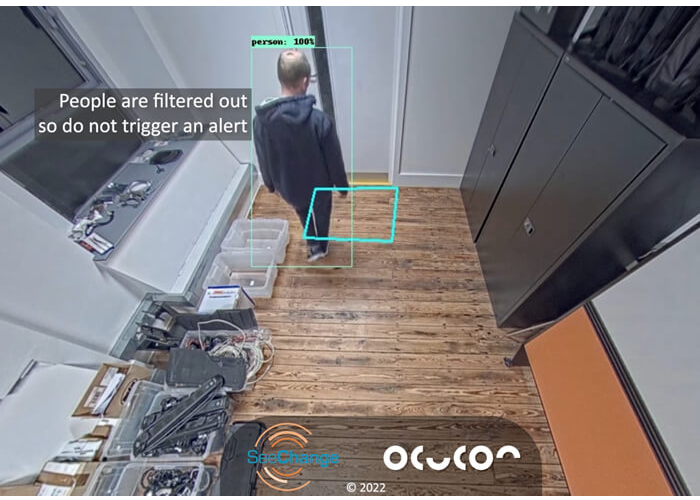Fire Exit Obstruction Software Monitoring Technology for Safety Compliance and the avoidance of Regulatory Fines
Fire Exit Obstruction Fines
What is the purpose of fire exits and why do we need them? Fire exits provide an extremely important and basic method of escape from buildings in the case of an emergency. Although they can be used for a raft of differing emergencies, they are mainly associated with evacuations arising from fires, hence typically being referred to as fire exits (source). As they facilitate emergency escapes, it is a requirement that fire exit doors open in the direction of escape and that they must not be locked or fastened in a way that cannot be easily and quickly opened by any person in an emergency situation (source).
Since fire exits play a vital role in reducing the number of fatalities and casualties caused by fire related incidents, they must be well managed and regularly maintained. Furthermore, as they are designed to facilitate escape when an emergency occurs, fire exits must be kept clear at all times (source). A failure to do so can lead to hefty fines, in the UK these are imposed by local Fire and Rescue Authorities, who have the power to initiate prosecutions related to serious fire safety breaches under The Regulatory Reform Fire Safety Order 2005 (source).
To give an example of the size of fines, high street retailers have faced penalties of up to £400,000 for breaches at a single location in the UK, as a direct result of storage blocking escape routes, a factor compounded by Insufficient staff training (source). Even the UK’s Atomic Weapons Establishment, a government run facility overseen by the Ministry of Defence, which is responsible for the design, manufacture and support of warheads for the UK's nuclear weapons program, received a £200,000 fine for Fire Safety Breaches in 2013 (source). Large fines for fire safety breaches are also common in the US, with the US Department of Labor’s Occupational Safety and Health Administration (OSHA) fining individual retailers for almost a quarter of a million dollars for blocked fire escapes (source).
Fire Exit Safety for Regulatory Compliance

In addition to being kept clear and unobstructed at all times, fire exits must also lead as directly as possible to a place of safety, so that they can provide both a basic and effective means of escape from fire (source). Furthermore, specific regulations also cover the design and width of fire exits, in the UK there are two main sources of guidance, one provided by the Building Regulations, which take a maximum number of persons approach, British Standards provides the other and uses the risk profile approach (source).
The Regulatory Reform Fire Safety Order 2005 places the duty to keep people safe from fire upon the Responsible Person (source). The Responsible Person is a legally created entity, defined within Article 3 of the Order, and they are required to carry out an assessment of the fire risks to people on the premises (source). They must ensure that routes to emergency exits from premises and the exits themselves are kept clear at all times (source).
Monitoring one or two fire exits within a single location may prove to be a relatively easy task for the Responsible Person, but what about those charged with the responsibility of ensuring safety within large organisations that may have thousands of outlets with multiple fire exits per location? This presents more complex organisations with somewhat of a sizable issue driven by the increased scale of monitoring that is required to ensure that they can continue to provide a safe means of escape for their customers and workforce from respective locations in the case of an emergency. It also provides plenty of opportunity for behavioural phenomena along with a poor perception of risk, namely traits hardwired into cognition, to once again raise their ugly heads (source) along with the potential for significant fines that result from non-compliance.
Fire Exit Software Technology for Monitoring Obstructions

Proprietary AI-based software, jointly developed by Ocucon and SeeChange that uses patent pending technology, provides a low cost automated solution for those organisations that wish to take pre-emptive action, to ensure that fire escapes remain unblocked and clear at all times. This highly sophisticated software, which also underpins our market-leading SpillDetect application, operates on existing CCTV networks. One of its key features is that it has the ability to adapt automatically to any floor plan and remove what would otherwise be the extremely laborious entry of floor plans into the application.
If you watch the attached video at the top of this article, you will note how the application ignores humans entering the protected area bounded by the blue outline at around 0:17s. Through having this out-of-the-box feature included, the model has the inbuilt capability to filter out what would otherwise be the potential for numerous false positives. As soon as an obstruction is placed in front of the fire exit, at around 0:28s, it is detected by the software, allowing the application to trigger an alert. Note also how detection zones auto-adjust against accidental camera movement, a point demonstrated at around 0:51s, which provides resilience against maintenance induced knocks that may result from cleaning, or changes in orientation by replacement.
This ground breaking technology more than illustrates how the latest developments in computer vision and AI software can help large and complex organisations deliver and maintain regulatory compliance, through the automatic monitoring of fire exits.

Low Cost Fire Exit Obstruction Monitoring through deploying AI Software over existing CCTV Networks
The continual consumption of resources and raw materials is placing an ongoing strain on our environment and this has raised the importance of re-use within society. Not only does the re-use of resources help society at large, it also reduces cost by minimising the need for additional expenditure (source). By providing an AI software solution, which does not require on-site hardware and is designed to operate with existing CCTV networks, our proprietary technology allows organisations to release latent value from the data that their systems already capture. Not only does this allow Ocucon and SeeChange to provide a low cost, low bandwidth solution it also allows businesses to recycle the cost of existing assets into additional uses, alongside their primary function of providing CCTV monitoring.
Designed as an API driven application, our technology works with all camera types. It can tap into multiple endpoints, from NVRs to VMS and even direct to cameras through RTSP, and has the capability to provide reporting through a raft of third party applications, or via the included dashboard. Furthermore, by serving real-time alerts and logging the time stamps of open and closed incidents, this powerful low cost AI software driven solution gives organisations instant access to a range of meaningful metrics, which can be used for building business processes and developing effective audit trails to facilitate Specific, Measurable, Attainable, Relevant, and Time-Bound or SMART KPI reporting.
Real-time detection of obstructions to fire exits not only leads to improved health & safety, but also raises wholesale levels of regulatory compliance, which prevents injuries caused by delayed egress during emergencies and reduces liabilities arising from fire exit blockages. We can deliver these benefits through rapid, large scale rollout programs that do not need additional on-site hardware or equipment.
Looking to improve health & safety and to benefit from the operational efficiencies that our ground-breaking computer vision products can deliver? Contact us now to learn how our technology can help you to differentiate your business through becoming the safest place to work, shop and eat.






